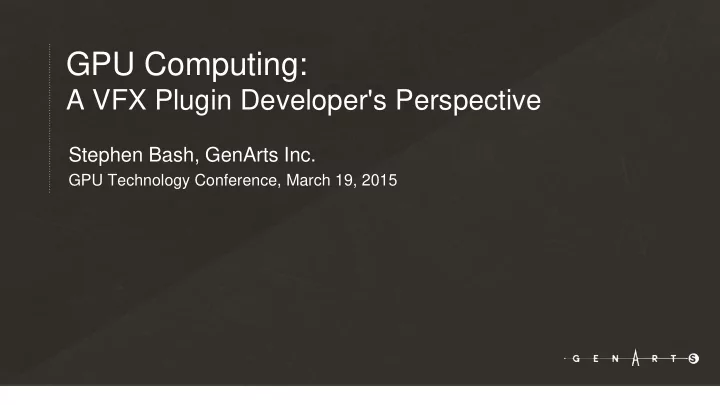

………………………………………………….. GPU Computing: A VFX Plugin Developer's Perspective Stephen Bash, GenArts Inc. GPU Technology Conference, March 19, 2015
GenArts Sapphire Plugins ………………………………………………………………………………………………………………………………………………………………………………………………………………………………………………….…………….. Sapphire launched in 1996 for Flame on IRIX, now works with over 20 digital video packages on Windows, Mac, and Linux Award winning collection of over 250 effects Effects composed from library of hundreds of algorithms: blur, warp, FFT, lens flare, … Algorithms implemented in both C++ and CUDA … and both must produce visually identical results 2
Outline ………………………………………………………………………………………………………………………………………………………………………………………………………………………………………………….…………….. Introduction What’s a plugin? Why CUDA? CUDA programming for plugins What works… … and what doesn’t Tips and tricks for living in someone else’s process Context management Direct GPU transfer Library linking Summary 3
4 Introduction …………………………………………………..
What’s a plugin? ………………………………………………………………………………………………………………………………………………………………………………………………………………………………………………….…………….. Shared library / DLL / loadable bundle API specified by host (program loading the plugin) Creates opportunity for third party to add features and value to host Host Plugin Operating System Hardware 5
How are plugins different? ………………………………………………………………………………………………………………………………………………………………………………………………………………………………………………….…………….. Plugin shares host’s process and resources Host Plugin Plugin errors can affect host Operating System Plugin may need to be reentrant and thread safe Hardware Lock discipline extremely important Requires careful memory management Plugin usually dependent on host for persistence Plugin must accept/support the host’s system requirements 6
Why CUDA? Performance! ………………………………………………………………………………………………………………………………………………………………………………………………………………………………………………….…………….. VFX artists require high quality renders with interactive performance Visual artist’s efficiency depends on seeing the result quickly VFX projects are getting bigger DVD 480p = 119 MB/sec HD 1080p = 746 MB/sec The Hobbit 5k stereo = 16.6 GB/sec! Interesting effects are complex Lens flares with hundreds of elements Automated skin detection and touch up Complex warps with motion blur Footage retiming CUDA enables interactive effects via powerful GPUs 7
8 CUDA for VFX Plugins …………………………………………………..
CUDA for Plugins: The Good ………………………………………………………………………………………………………………………………………………………………………………………………………………………………………………….…………….. CUDA provides significant speed gains for our effects CUDA is OS-independent Cost effective performance for customers Cheaper and easier to upgrade GPU Hosts are beginning to support direct GPU transfer of images * Plugin only performance rendering 1080p 9
CUDA for Plugins: The Bad ………………………………………………………………………………………………………………………………………………………………………………………………………………………………………………….…………….. Long running kernels cause Windows to reset driver Reset can break/crash host NVidia cards are scarce in Macs GPU sharing with host is relatively undocumented Many hosts monopolize GPU resources Host APIs lack tools to coordinate over multiple GPUs 10
CUDA for Plugins: When Things Go Wrong ………………………………………………………………………………………………………………………………………………………………………………………………………………………………………………….…………….. Provide CPU fallback for all effects // Try to execute on GPU bool render_cpu = true; A single black frame can ruin a long project if (supports_cuda(gpu_index)) { Also allows heterogeneous render farms if (execute_effect_internal(gpu=true, ...)) render_cpu = false; // GPU render succeeded Implementations can differ, but results } have to visually match // Execute on CPU Test infrastructure keeps us honest // If GPU render failed, this will retry on CPU if (render_cpu) execute_effect_internal(gpu=false, ...); Example: S_EdgeAwareBlur Preprocessor stores result differently on CPU Result CPU/GPU Error* CPU and GPU Three different blur implementations Final results are not numerically identical, but are visually indistinguishable * Color enhanced to show detail 11
12 Tips and Tricks …………………………………………………..
CUDA Context Management ………………………………………………………………………………………………………………………………………………………………………………………………………………………………………………….…………….. Host might use CUDA Need to isolate plugin errors (e.g. unspecified launch failure) from host CUDA contexts are analogous to CPU processes and isolate memory allocations, kernel invocations, device errors, and more Plugin can use the driver API to create its own context and perform all operations in that private context Library context management CUDA 6.5 Programming Guide, Appendix H 13
CUDA Context Management ………………………………………………………………………………………………………………………………………………………………………………………………………………………………………………….…………….. Requires use of driver API // Persistent state static CUcontext cuda_context = NULL; static CUdevice cuda_device = -1; // initialized elsewhere To support running on machines with CudaContext::CudaContext(bool use_gl_context) { different driver versions, load driver if (!cuda_context) { // Create new context if (use_gl_context) at runtime rather than linking it cuGLCtxCreate(&cuda_context, 0, cuda_device); else directly cuCtxCreate(&cuda_context, 0, cuda_device); On Mac weak link the CUDA } framework cuCtxPushCurrent(cuda_context); } If an error occurs, destroying context CudaContext::~CudaContext() { cuCtxPopCurrent(NULL); will free plugin’s GPU memory and } reset device to non-error state 14
Direct GPU transfer ………………………………………………………………………………………………………………………………………………………………………………………………………………………………………………….…………….. CPU Memory CPU Memory GPU Memory GPU Memory Plugin Plugin Context Context Host Data Naive GPU-accelerated host copies data back to CPU memory for plugin 15
Direct GPU transfer ………………………………………………………………………………………………………………………………………………………………………………………………………………………………………………….…………….. CPU Memory GPU Memory Plugin Context OpenGL Host Context Data Naive GPU-accelerated host copies data back to CPU memory for plugin OpenGL is the cross-platform solution for sharing between multiple GPU languages May require extra memory copies if host isn’t natively OpenGL OpenGL/CUDA interop on Mac is really slow 16
Recommend
More recommend